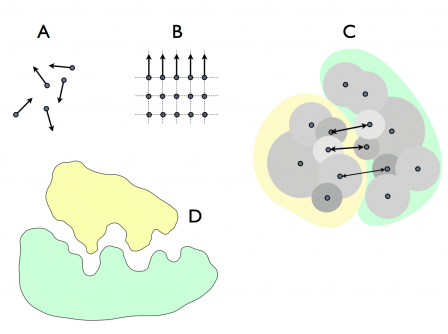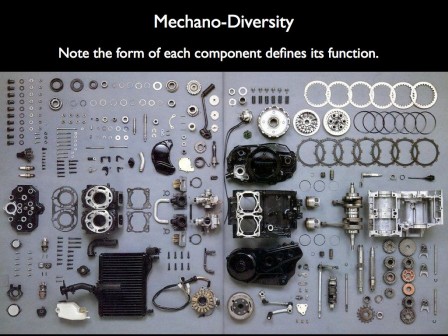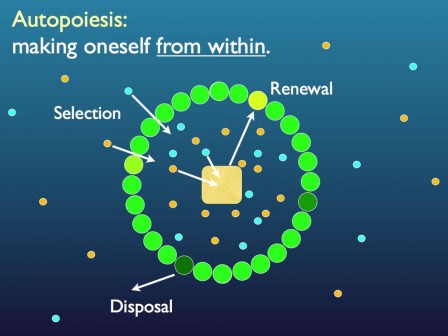By Keith,
Monday, April 25 2022.
Permalink
In this post, I highlight the way thinking about physical reality from an 'information perspective' gives us a bridge between biology and physics. Why, you might ask, and the answer is that many physicists who are willing to think deeply about life (as a phenomenon) find it very puzzling indeed because it seems to defy some very basic principles. I might be wrong, but I currently believe that the information perspective allows us to see what is the essential difference between a living system and one that is not. The answer lies in the accumulation of information, its protection from being either affected by or affecting (as formal cause) physical forces ... that is, until it is required. The explanation I build up in Farnsworth (2022) "How an information perspective helps overcome the challenge of biology to physics" (
Biosystems 104683) manages to make downward causation, irreducible hierarchies, circular causation and autopoiesis all compatible with normal physics - there is no need for a special 'life' law.
Physicists puzzled
Several years ago, on one of my rare trips to an international conference in America, I ended up in discussion with
Sara Imari Walker - leading astrobiologist and proponent of information thinking in physics. Surprisingly, she insisted physics could not alone explain life. Her senior colleague (
Prof. Paul Davies) has often said (more guardedly) that he thought that certain things we see in biology indicated there was more to physics than we currently knew. Schrödinger had famously mused (in his book 'What is Life?') that "other laws of physics" might be needed to explain life, so this is not a new concern. Anyway, I disagreed with Sara, who put the point more forcefully, citing (as one does) things like protein folding and the astonishing
autonomy of living things which does indeed seem to violate the 'law of cause and effect'. As Paul (Davies 1999) says: throw up a dead bird and its trajectory is predictable by physics, but do the same with a live bird and what happens next is anyone's guess "perched improbably on a television aerial across town, or on the branch of a tree..." (for those that remember TV aerials). You get the point - life seems to defy physics because it seems to have the ability to overrule at least some local instantiations of the laws of physics.
Yes, it seems to, but I'm sure it does not. What is more, these laws (the general laws of thermodynamics, forces and quantum symmetry etc.) are absolute and not for breaking, but their particular effects, in practice, always depend in the particular circumstances - usually the initial conditions or the boundary conditions of the system in question. It is the manipulation of those (free to change) particular conditions that gives life the scope for apparent autonomy. The particular conditions are in fact just the position of every relevant particle in space and time and the set of their positions is what I call embodied information - both information about where all the particles are and the information presented by them being where they are (embodying that data).

Here's what I mean. In the diagram, A shows particles moving at random - their position changes and embodies no information at all because the positions are always random (the opposite of information). In B, they are arrayed in an ordered configuration (a simple sort of pattern), as a crystal, which because it is thermodynamically stable (low Gibbs free energy), it does embody information. You can think of that as information which can be gleaned now about the configuration some arbitrary time before (when it was still like that). In C, we extend this to a more complicated and biologically interesting pattern - atoms arranged in a more or less stable configuration as a pair of biologically significant molecules that are interacting via their electrical forcefields (from outer orbital electrons). The interaction here depends on the shapes of those forcefields - if they match (to some extent at least), then interesting things happen, such as binding, ligation, recognition, cleaving and so on. This is abstracted in D, which illustrates the classic idea of a lock and key pairing, for example in cell signalling, or even the selective binding between a transfer RNA molecule and its matching amino acid, or even more clearly its codon-anti-codon recognition base-pairing.
Of course there is much more to life than that - these are just examples of the most basic nuts and bolts. What puzzles physicists is how we go from this sort of thing to autonomous organisms.
Circular causation and hierarchies of causal control
The big mystery lies in the two strange organisational phenomena of circular causation and hierarchies of causal control (especially downward causation) - things causing themselves and emergent patterns controlling the bits they are made of. Should be impossible, right? Most of my paper deals with causation in living systems. Firstly (and it helps a lot), I clarify Aristotle’s notion of four aspects to causation, for the first time showing that efficient cause (the normal meaning of making things happen) is strictly the result of information embodied patterns constraining the direction and strength of physical force fields at the atomic scale. That is, information determining the configuration of atoms (e.g. in the molecules described above) which sets the boundary conditions and thereby organises forces into functional action. Put simply, Aristotelian formal cause is embodied information; efficient cause is physical force constrained by formal cause and material cause is just a micro-formal cause, i.e. information embodied at the atomic level. (see
The Physical Basis of Causation).
Puzzle 1: how can information control physical things?
Given this picture of information embodied as persistent spatial patterns constraining forces, we can see that what has been such a puzzle for physicists - that “intangible information can exert causal power over physical reality” (Paul Davies) - is nothing special. The patterns in the atoms set the boundary conditions for the general forces of nature to act and by setting these, the information, embodied in, and forming the patterns exerts its control. Physical reality is the combination of the fundamental forces, all of which eminate from the quantum phenomena formally known as particles (!) acting on those particles (by exchange of more particles among them), all instantiated in specific cases that depend on the spatio-temporal configuration of the set of particles involved (i.e. where they happen to be at the moment). The forces are: colour force among gluons which leaks out to make the strong nuclear force, electro-weak force makes electrical and magnetic fields as well as the weak nuclear force and then there is gravity (which admittedly is still a bit of a mystery in some respects). And that's all. Information exerts its control by setting the
particular configuration for the general action of forces.
Puzzle 2: how can emergent phenomena be only partly determined by their components?
This is the problem of ‘hard emergence’, i.e. the creation of phenomena, seemingly out of nothing, whereby things happen that cannot, even in principle, be explained by knowing everything there is to know about the parts making up the whole. The classic (and much probed and fretted over) example is the mind which emerges from (mainly) neural activity. Leading philosopher
Jaegwon Kim argued that this kind of emergence was a fallacy, but we still seem to need it to explain so much in biology.
On the
Emergence page, I show how easy it is to overcome Kim’s challenge using the information perspective. It largely revolved around the ‘exclusion principle’: that an effect cannot have more than one immediate efficient cause. In the mind-body problem that principle conflicts with the (otherwise) popular idea that the mind has both a physical and a metaphysical cause, but a bodily event and mental event cannot both together be to blame (that would be a violation of the exclusion principle). In the information perspective, we don’t have this separation between the physical and the mental: both are just information embodied in the spatio-temporal patterns of atoms. Whether we describe physical (neurons) or mental (the pattern of their excitation states), it is all just information in the end. More generally, hard emergence is found not to be magical at all, but simply the fact that low level patterns (e.g. molecules) can be arranged in a
particular higher level pattern, the properties of which are not determined solely be the lower level patterns. What is left undetermined, is the apparent mystery of something out of nothing, but it is really just the higher level pattern. If you are not satisfied with that explanation, I recommend reading the Appendix of the
2022 paper - it is done rigorously there.

Is the set of components shown (left) really enough to fully describe an engine? Of course not, we also need the plan of how those bits fit together to make a functioning whole. That is why we cannot reduce a cell to its component molecules and expect to understand how it works, or even what it is.
Puzzle 3: How can the hierarchy of biological organisation be irreducible to basic components?
This is, of course, related to the second puzzle. Most biologists are arch reductionists (fair enough, the reductionist paradigm has served us very well). But it means we cannot understand why e.g. a cell, or a multicellular organism cannot, even in principle, be fully explained strictly in terms of molecular interactions. It’s that same freely flying bird problem again, this time in mechanistic detail. The answer (also to be found in my 2022 paper) is that each level, in a hierarchy from atoms to the global ecosystem, has its own particular
functions (efficient causes that contribute to the operation of the next higher level). These functions are always the result of two ontologically different things: the pattern information embodied at the level in question (L) and the functions of the parts from which it is composed (each of level L-1). We cannot combine functions and patterns any more that we can combine apples and poems (that’s what I mean by ontologically different things). However, to explain level L functions in terms of level 1 objects, we would absolutely have to combine those things. Again, I refer you to the paper for a rigorous treatment.
Puzzle 4: How can a thing be the cause of itself?
This is the problem that ‘Relational Biology’ was created to solve. Rosen’s (M,R)-system is an abstract representation of the solution, but has proved extremely hard to interpret in biologically realistic terms. Maturana and Varela’s
autopoiesis is a bit closer to the biology, but still far from satisfactory for a regular lab-based biologist. Jannie Hofmeyr adapted the (M,R)-system idea (see previous blogpost) to produce the first biochemically realistic model of the cell in organisational terms, showing how genetic material, metabolic cycles and the cellular milieu combine to form a system that is
closed to efficient causation (
clef): literally engaged in self-making.

Showing how information molecules (DNA and RNA) are critical to this organisational structure was a big leap forward. It turns out (as I explain in my 2022 paper, using Von Neumann’s self-reproducing system theory) that a clef system is impossible without the addition of information that has been accumulated elsewhere. This information is what Von Neumann called a ‘blue print’ and we all know what that means in biology - it is the information acquired over thousands of generations of evolution by natural selection to specify the species of organism and all its behaviours in DNA. A cell is a cause of itself, in the sense of self-making, only in so far as it maintains itself by constantly remaking and replacing its component parts. It is not self-making in the (paradoxical) sense of conjuring its own existence out of nothing (or even primordial soup). As I often say - every cell in my body and in any other living thing, including all the bacteria, alive today, is the nth generation daughter of the first cell that ever lived: new cells are created by fission, during which the outer membrane is never broken - actually we are all made out of divided bits of the first ever cell. When this fission takes place, the membrane is shared between the two daughters, so is the cytoplasm with all its functional jelly contents.
And finally, what Inspector Cluseau would call ‘le pièce de résistance!’ …
The 5th puzzle: How can an organism defy the laws of cause and effect to do what it wants?
The answer, again is rather prosaic - it does not. Sure it can do what it wants, but not by defying any physical laws and not even by defying cause and effect (determinism). The trick is to realise that everything happens the way it does because of the particular arrangement of atoms in the system (which, remember, determines the effect of physical forces). That arrangement is embodied information and the special feature of organisms, in this respect, is that they can embody their own (private and exclusive) information. The fundamental unit of action-determining private information is that embodied to inform a set-point in a homeostatic control system (like the setting on the thermostat in your central heating or air conditioning system). Homeostasis simply does not exist in nature beyond life (equilibrium, e.g. in the balance between gravity and entropic forces of a star is just a thermodynamic balance, not a set point). Living organisms (even the simplest cellular life) are full of homeostatic controllers, each with a little bit of exclusive information. What is more, the set-points can be altered according to circumstances by changing the information (e.g. by altering the shape of the molecules that embody them). This is done with an outer, or hierarchically superior homeostatic system, and so it goes on - each cell an interacting set of homeostatic systems within homeostatic systems. This, alone, does not make a thing that can really choose for itself what to do, but it does mean that its actions are not entirely determined by the outside world - in part they are determined by the internal information and the algorithm (also internally embodied information) that specifies the way it is acted upon.
The next step is for the organism to also embody information that amounts to a model of itself in its environment (See Farnsworth 2017; 2018). With that, the organism can anticipate possible outcomes of a range of optional actions - even before any action is taken. All that is computing, i.e., information manipulation - and this is what neural networks are really good at. Higher organisms like birds will use such an internal self-model to select their next action from a range of options and end up on the TV antenna. No magic, no paradox, just wonderful biological information processing. References
Davies, P.W.C. The Origin of Life. Penguin Science. 1999.




